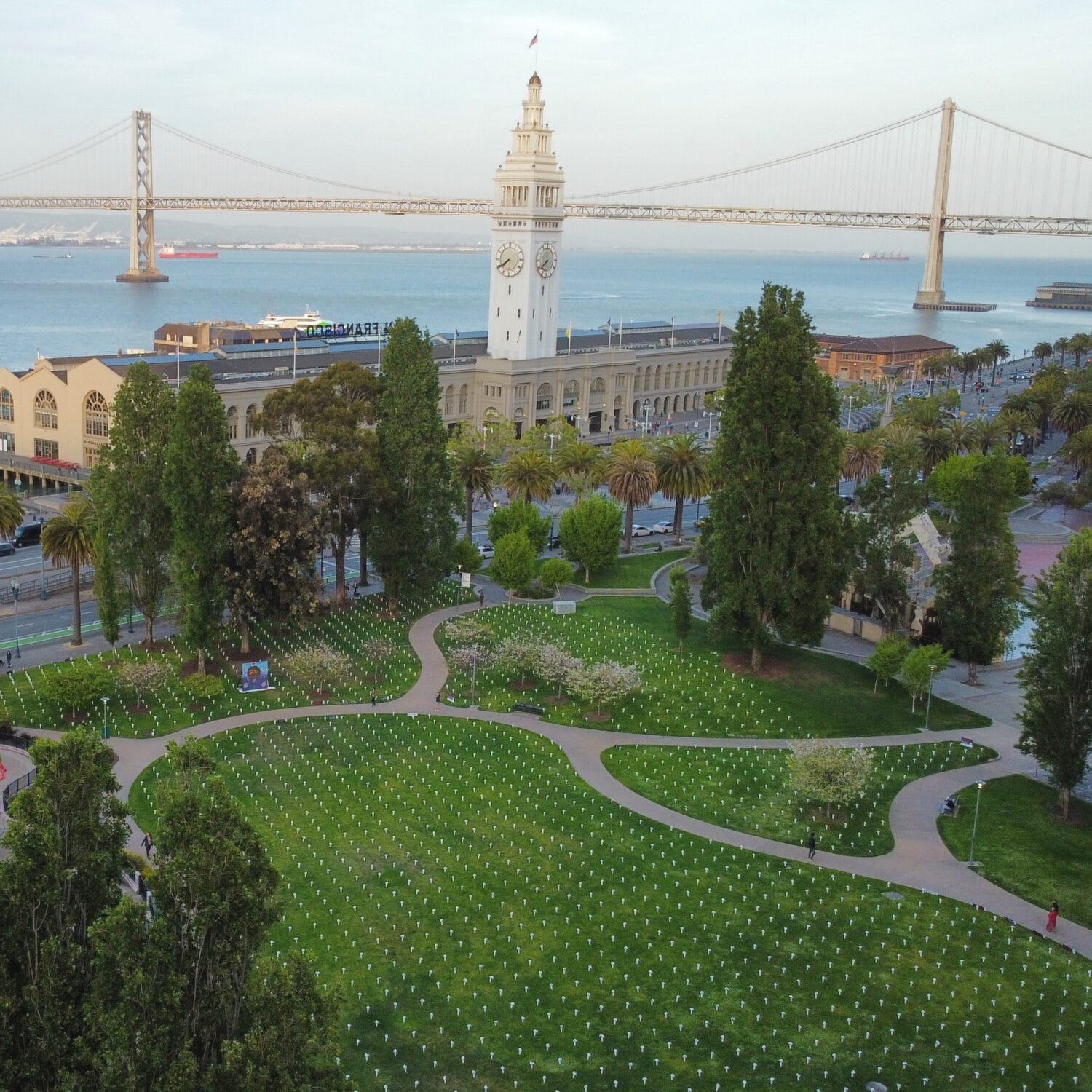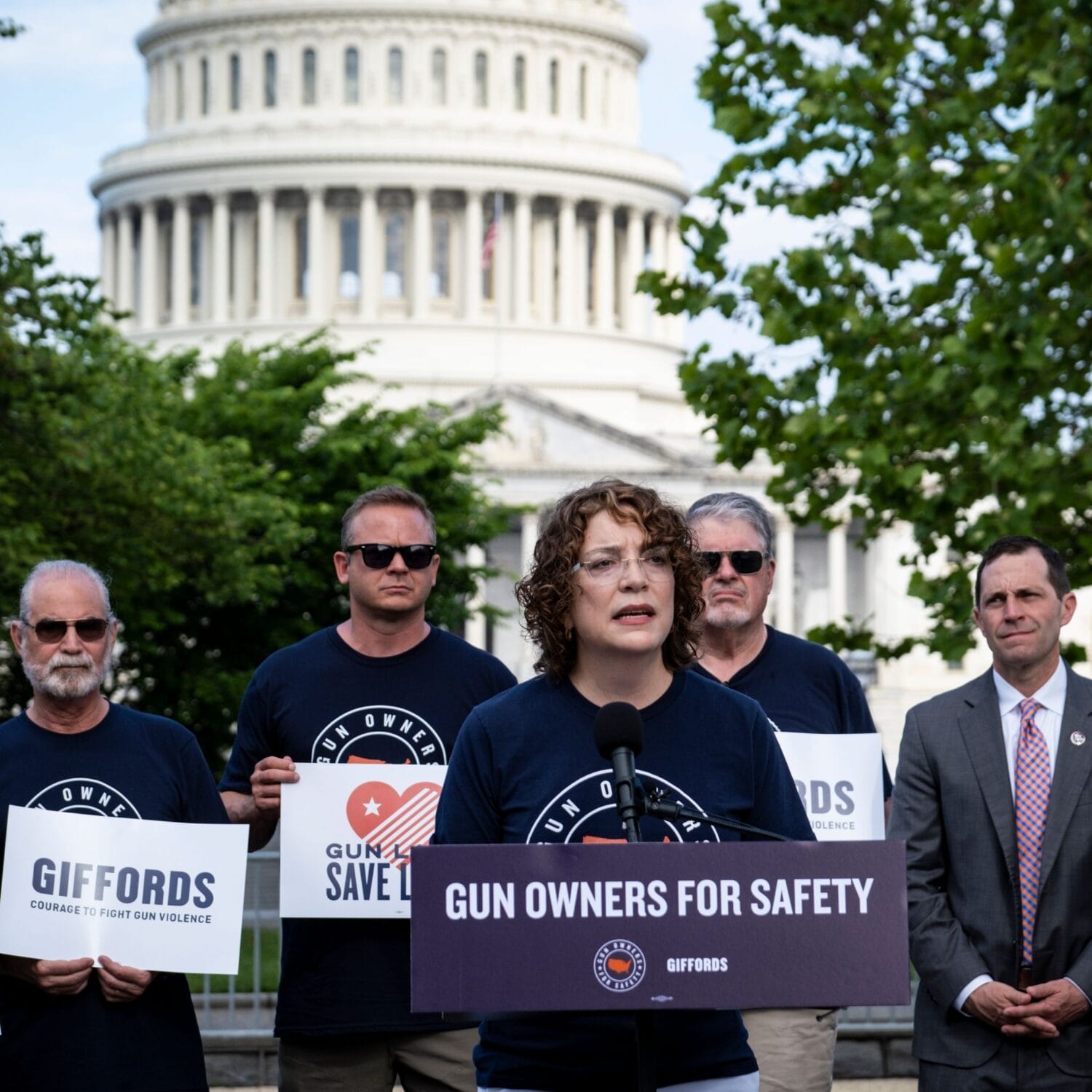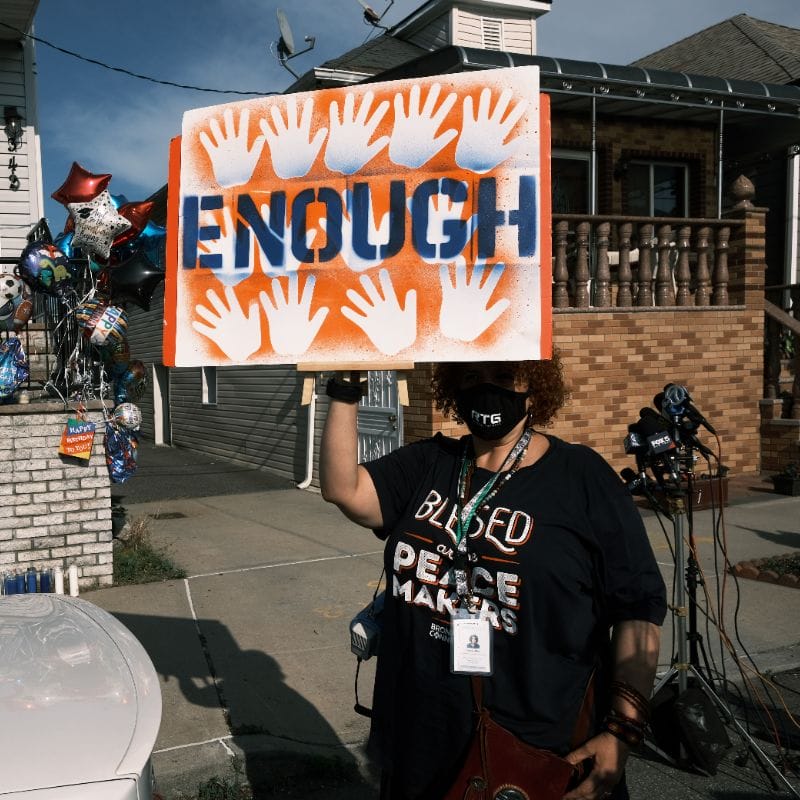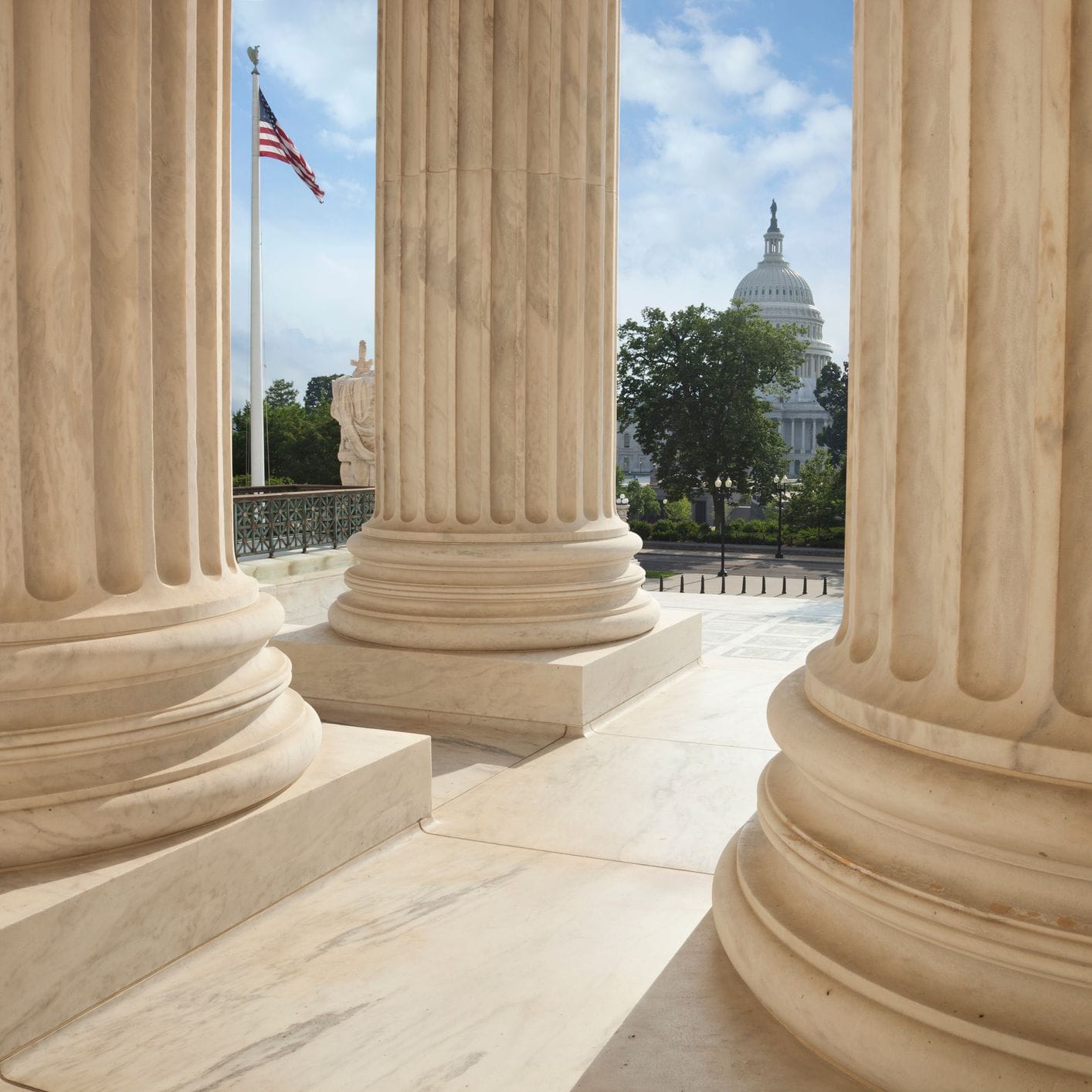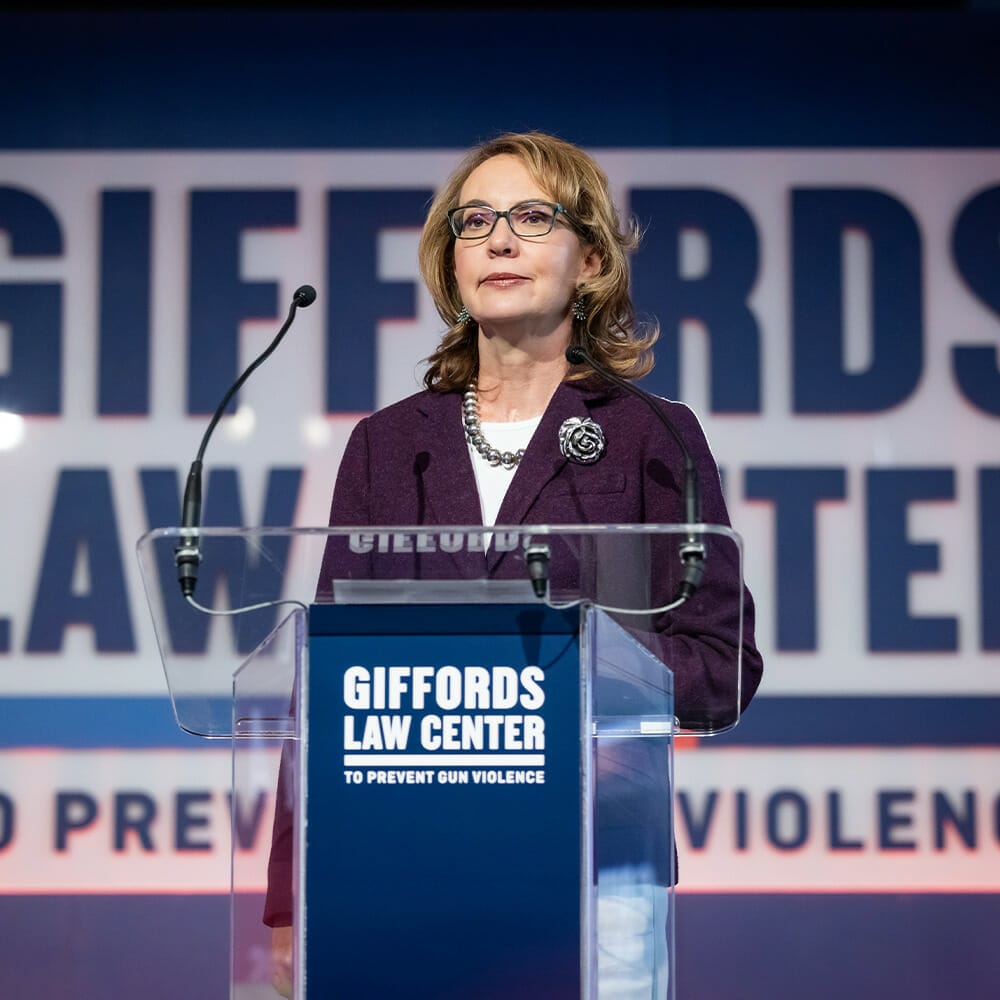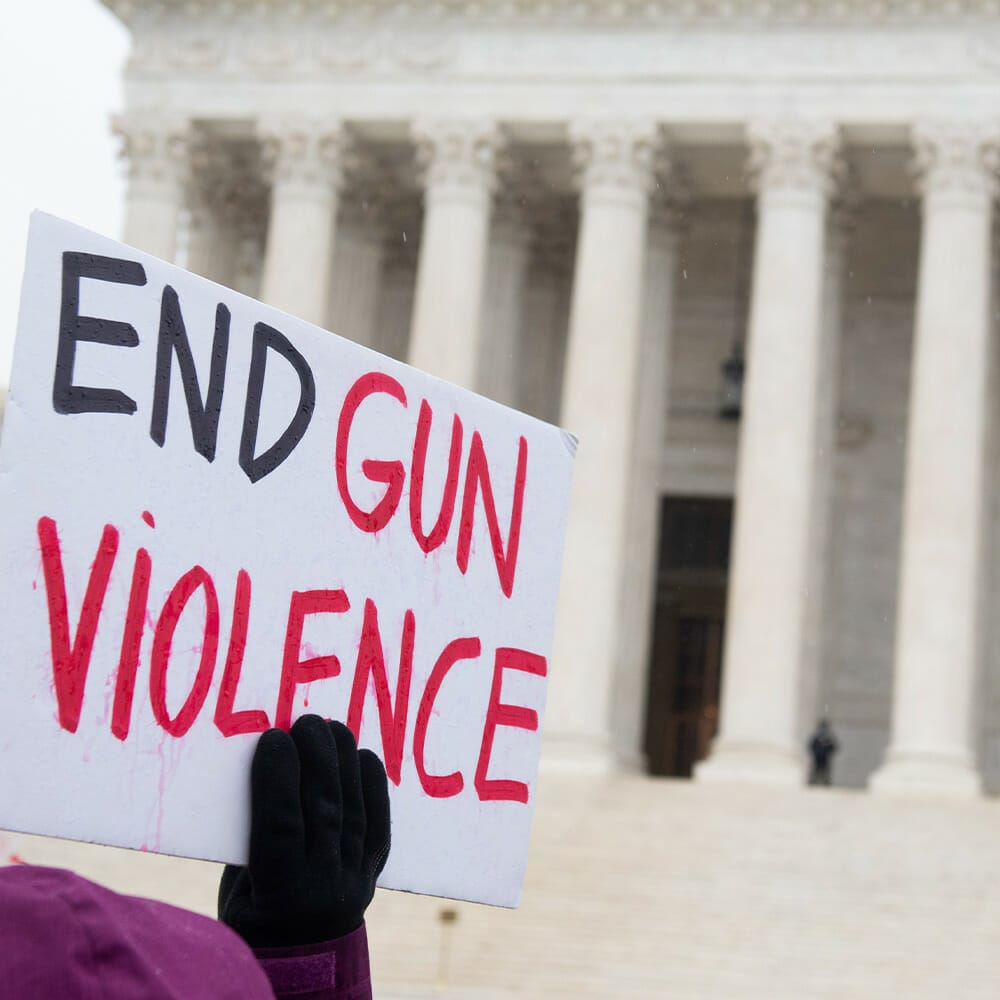
Leadership in the Storm: Gavin Newsom and Gun Safety in California
For years, California has had the strongest gun laws in the country, and these efforts have been reflected in the state’s declining gun death rate. But the state has faced significant challenges in recent years, especially since the start of the COVID-19 pandemic. In particular, alarming national trends and a fast-growing ghost gun crisis have threatened to reverse decades of California’s hard-won progress. All of the state’s accomplishments on gun safety are also under renewed threat today from radical right-wing judges seeking to dismantle the gun safety model California has built.
This report tells the story of how California is rising to meet these challenges. Despite all it faces, over the last four years—under the leadership of Governor Gavin Newsom—California’s gun safety efforts have only accelerated to tackle these threats head-on. In 2023, the governor signed more than a dozen gun safety bills into law, cementing California as a leader on this issue.
Record Surge in Gun Sales
Like nearly every other corner of the US, California faced an enormous spike in both gun sales and gun murders during the pandemic in early 2020. Californians legally acquired an estimated 800,000 guns in 2019, but more than 1.25 million in 2020—a 56% increase in just one year.1 This surge in gun sales cooled somewhat in 2021 and into 2022, but Californians still legally bought about 20% more firearms in 2021 compared to 2019 levels, and gun sales remained modestly elevated throughout most of 2022. In total, between March 2020 and March 2023, Californians acquired more than three million additional firearms,2 over 600,000 more guns than would have been expected based on robust pre-pandemic sale trends.3
Data from California indicates that many of these guns were purchased by first-time buyers. The number of people with at least one legal firearm acquisition recorded in California Department of Justice records increased by 21% in the two years between January 1, 2020, and January 1, 2022.4 In other words, the number of recorded gun owners in California swelled by more than 20% in just two years.
It’s important to note that these gun sale estimates very substantially undercount the true number of guns that flooded into California’s communities in recent years through illegal trafficking and, especially, a fast-growing ghost gun crisis.
The Ghost Gun Crisis
Over the past decade—and especially since the start of the pandemic—the US has suffered an explosion in the market for “DIY” ghost gun build kits and related products that allow people to easily assemble their own firearms without any background check, sale record, serial number, age or ID check, or other protections.
These ghost gun products were designed to circumvent gun safety laws, especially in California. By contending that California’s gun safety laws applied only to fully assembled “firearms” or completed firearm frames or receivers, the ghost gun industry created a dangerous new market in nearly-assembled and nearly-finished gun build kits. These products were left just unassembled or “unfinished” enough for the ghost gun industry to argue that it could escape the definition of “firearm” or “frames and receivers” used in California and federal gun safety laws.
While responsible firearm dealers and manufacturers complied with California’s public safety and consumer protection laws when selling assembled firearms, ghost gun companies sought to gain a competitive advantage by saying these laws didn’t apply to their firearm build kits and by aggressively marketing these products to buyers interested in arming themselves with lethal weapons without any background check and without any trace.
As a result, the ghost gun industry was able to sell untold numbers of ghost gun products without meeting even basic consumer safety and reliability tests for firearms. It sold products directly, immediately, and often anonymously to buyers who never passed a background check or gun safety test and never showed ID verifying their age. It sold these products without any official sale record too, meaning that the only reliable metric for understanding the true scope of the ghost gun crisis has been the trail of harm and carnage it has left behind—an increasingly huge number of “privately manufactured” unserialized ghost guns recovered from crime scenes and other law enforcement investigations across California.
In 2015, as the ghost gun market began to emerge, California law enforcement agencies reported recovering a total of 26 “privately manufactured” ghost guns from crime scenes statewide. In response to this threat, our organization partnered with California Assemblymember Mike Gipson and other allies to introduce the nation’s first comprehensive ghost gun reform bill in early 2016; that legislation sought to require ghost gun companies selling unfinished ghost gun components to comply with all of the laws governing the sale and manufacture of fully assembled firearms.5 In our testimony to the California Assembly Public Safety Committee in support of that 2016 bill, we stated:
A January 2016 report to Congress by the U.S. Government Accountability Office confirmed that ‘Recent seizures of firearms parts, firearms made with unmarked parts, and equipment used to assemble or manufacture firearms . . . suggest an emerging reliance by criminal organizations on this source of weapons.’
These products’ sole function is to be modified and assembled into an operable weapon and they should be regulated accordingly.
Unfortunately, that bill was vetoed by then-Governor Jerry Brown in 2016. In the ensuing years, the ghost gun crisis truly took off: The number of ghost guns recovered from crimes by California law enforcement agencies climbed from 26 in 2015 to more than 1,600 in 2019 and at least 12,894 in 2022.6
But it’s worth noting that in June 2022, Governor Newsom signed AB 1621, a bill that comprehensively strengthened regulations against the ghost gun industry and took effect immediately. It’s too early to determine how much of an impact it had, but while the number of recovered ghost guns rose 165% from 2020 to 2021, it only rose by 4% from 2021 to 2022.7
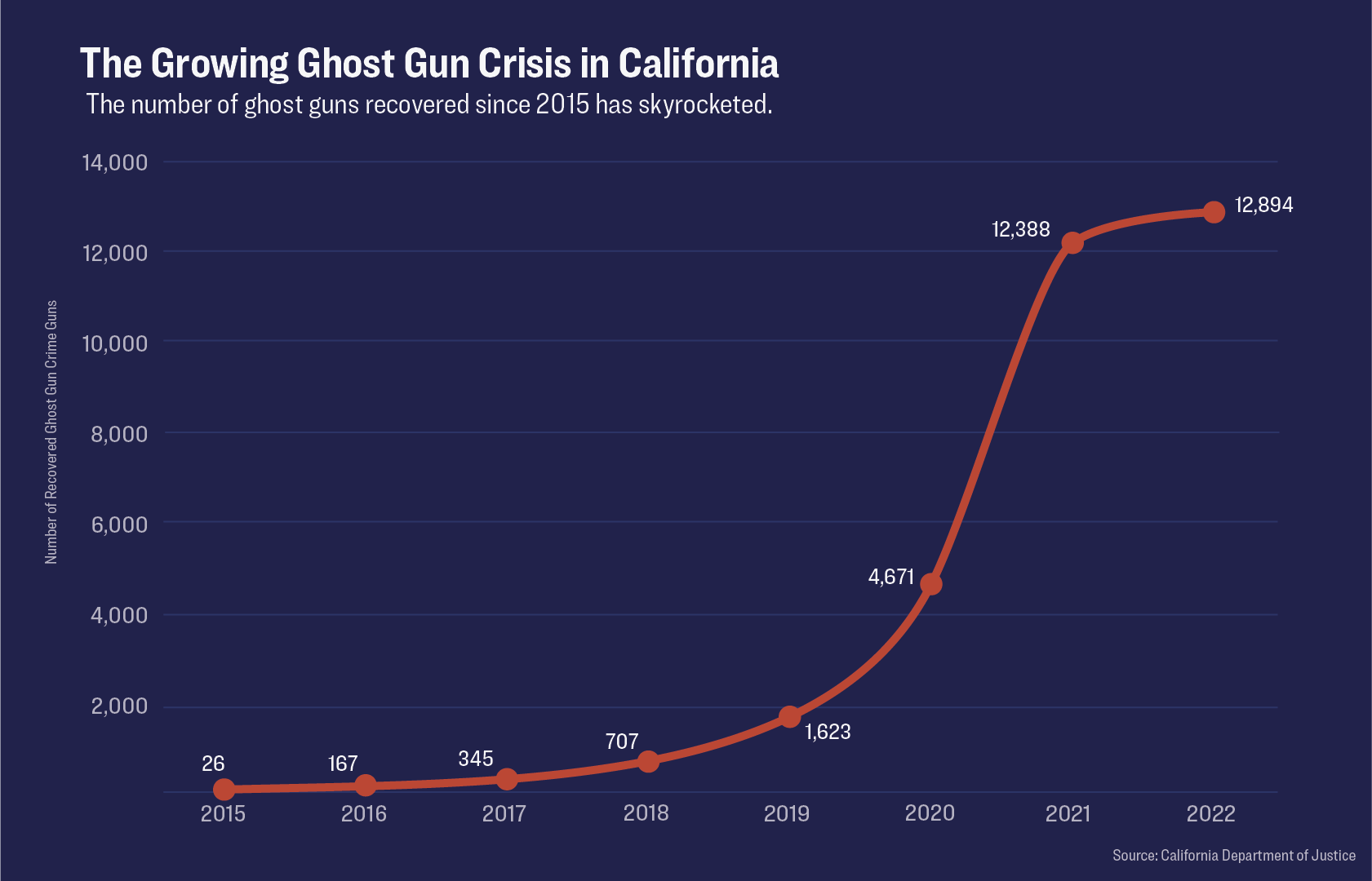
This stark increase in illegal ghost gun recoveries quickly grew worse throughout the state.
- Unserialized ghost guns comprised 6% of guns recovered in San Francisco homicide cases in 2019 but 44% in 2020, according to law enforcement officials.8
- Law enforcement officials in San Diego reported recovering 360 ghost guns in just the first nine months of 2021, more than four times as many as the department recovered in all of 2019.9
- According to an October 2021 report by the Los Angeles Police Department, the number of ghost guns seized by the LAPD increased 400% since 2017 and more than doubled from 2020 to 2021 alone. The report concluded that “the current trend shows these figures will continue to grow exponentially” and that “ghost guns are an epidemic not only in Los Angeles but nationwide.”10
- In August 2021, the Los Angeles Police Department reported that ghost guns accounted for 33% of all guns recovered by the department in its investigations of suspected criminal activity.11
Community violence intervention professionals have also confirmed that the proliferation of ghost guns in California’s most vulnerable communities has intensified and contributed to the surge in shootings disproportionately impacting young people. A May 2021 report by The Guardian began with a telling anecdote:
“Who would waste time going to Nevada when you can just get them in the mail and put it together?” the Stockton teen nonchalantly replied.12
Additionally, ghost guns have fueled horrific domestic violence shootings, mass shootings, and murders of on-duty police officers by people who were legally disqualified from buying fully assembled guns but were nonetheless able to acquire unregulated ghost gun products without a background check.13
California has been at the epicenter of this ghost gun crisis. In 2020, nearly two-thirds of all ghost guns seized by ATF enforcement operations across the entire country were recovered in one state: California.14
That fact is a testament, in part, to the strength and importance of California’s gun safety laws. In most other states, people can more easily acquire guns without any background check, serial number, or sale record. In California, by comparison, it is much more difficult for people who know they would fail a firearm background check or who wish to conceal their involvement in gun trafficking to acquire fully assembled guns anonymously. As a result, the ghost gun industry aggressively pursued buyers in California who may be seeking to circumvent the state’s strong gun safety laws.
Record Recent Spikes in Gun Homicide in California and Nationally
The pandemic—coupled with the related national trauma and economic crisis, a record flood of gun sales, an exploding market in ghost guns, and a crisis of confidence in law enforcement—coincided with an unprecedented spike in gun violence.15 In 2020, the nation suffered the largest one-year increase in homicides ever recorded,16 driven by a 35% spike in firearm homicides between 2019 and 2020 alone.17 US gun homicide rates continued to climb and remained at record levels throughout 2021 and 2022.
Nationally, this increase in shootings occurred on top of an alarming longer-term increase in gun violence, as the nation’s gun homicide rate has risen 70% over the past decade.18Altogether, Americans were nearly twice as likely to be murdered with a gun in 2020 than one decade before.19 Over the past decade, gun violence increased even more dramatically for the nation’s youngest, with gun violence becoming the leading cause of death for children in 2020.20 In fact, gun homicide rates for children 14 and under more than doubled between 2013 and 2022.21 In 2022, American children ages 0–17 were nearly twice as likely to die from gunshot wounds than from all cancers combined.22
These national trends have affected California too, threatening decades of hard-won progress on gun safety. After California achieved record-breaking decreases in gun homicide before the pandemic, the state suffered a huge 42% increase in gun homicides between 2019 and 2020 alone.23 Compared to monthly trends from previous years, the 2020 gun homicide spike emerged in March 2020 at the onset of the pandemic and accelerated after June 2020 throughout the remainder of that year.
In California, this spike in gun homicides occurred across nearly every age group, every race and ethnicity, and for both men and women, but it was primarily concentrated in communities that were already disproportionately impacted by gun violence. Gun homicide rates rose 66% for Black women in California and 68% for Black men.26 Geographically, homicide rates increased in nearly every corner of the state.27 Some counties saw huge spikes in their gun homicide rates, with Oakland-based Alameda County seeing its rate nearly double (93%) from 2018 to 2022.28 During the same time period, counties like Sacramento County (40%), San Bernardino County (87%), and Fresno County (89%) all saw substantial increases.29
Some data indicates that across California, victims of domestic violence have faced significantly increased risks from firearms since the start of the pandemic. From 2018 to 2022, the statewide number of domestic violence–related 911 calls involving firearms rose by 54%,30 and the rate of women and girls killed by gun homicide in California rose nearly 19%, with especially large increases for Black and Hispanic women and girls.31
Recent spikes in gun violence have also exposed law enforcement officers to increased safety threats. While assaults on law enforcement officers overall increased by 10% between 2018 and 2022, the number of such assaults involving firearms in California increased by 28%.32 Four officers were feloniously killed in the line of duty in California in 2022, three of which died by gun violence.33
Inequality in Safety
Communities across the country, including California, continue to experience stark inequities in safety. As a leading sociologist wrote, “America’s haves and have-nots are divided not just by how much people earn, where they went to school or what car they drive, but more fundamentally by whether they feel safe when they tuck their kids in at night.” Interpersonal shootings are disproportionately concentrated in neighborhoods marked by past and present racial exclusion, segregation, and the compounding challenges of concentrated poverty and disadvantage; this violence’s toll falls overwhelmingly on people of color. In 2022, 81% of California’s gun homicide victims were Black or Latino.34
For the highest risk age group—boys and men aged 15 to 24—gun homicides accounted for 4% of all deaths among young white boys and men in California from 2018 to 2022.35 But it accounted for 6% of all deaths among Asian and Pacific Islander men and boys in the same age group,36 17% of deaths among young Hispanic men and boys the same age,37 and 36% of deaths among young Black men and boys the same age.38 Nearly 94% of Black male homicide victims in this age group were killed with guns.39 While the racial safety gap is much wider in most of the rest of the US, it remains one of the starkest examples of racial inequity in California today.
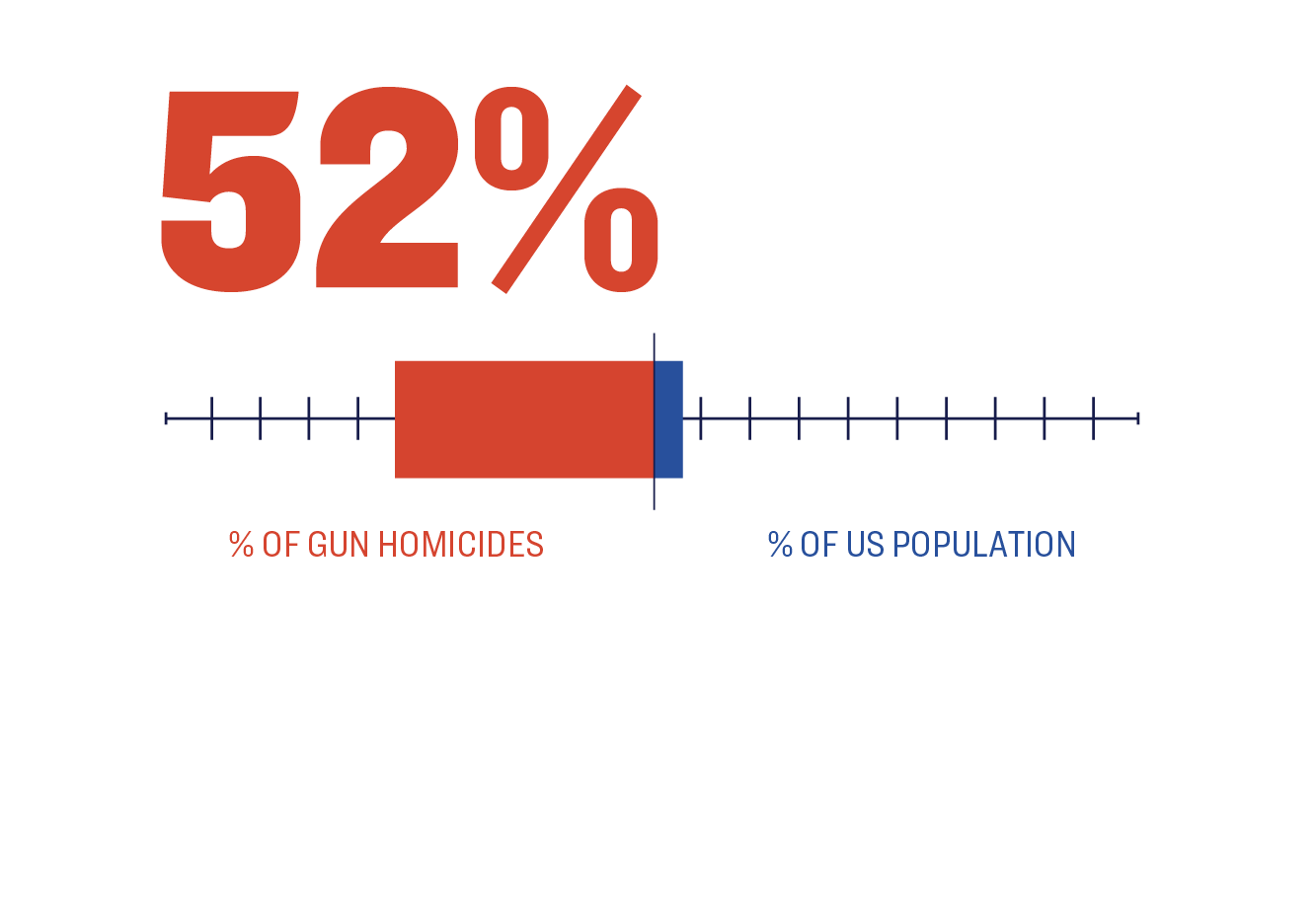
Over half of gun homicide victims are Black men
Source
Centers for Disease Control and Prevention, Wide-ranging Online Data for Epidemiologic Research (WONDER), “Underlying Cause of Death, 2018-2023, Single Race,” last accessed February 3, 2025, https://wonder.cdc.gov/.
Geographically, California’s Central Valley suffers disproportionately from gun violence. From 2018 to 2022, Kern County (which includes the city of Bakersfield) saw a gun homicide rate more than double the statewide rate.40 During the same time period, San Joaquin County (which includes the cities of Stockton and Tracy) and Fresno County both suffered gun homicide rates that were nearly twice the statewide average.41 The next five counties with the highest gun homicide rates in the state included multiple largely urban counties in California’s Central Valley or Inland Empire, including Merced, Solano (which includes the cities of Vallejo and Fairfield), and San Bernardino, as well as Oakland-based Alameda.42
From 2018 to 2021, female victim gun homicide rates were at least double the statewide rate in two counties: Kern and Fresno.43 These counties comprised close to 5% of California’s population but suffered 11% of female victim gun homicides.44
Due to its enormous population, Los Angeles County also has an outsized effect on statewide data and trends: Los Angeles County has just over one-quarter of California’s population and suffered 32% of the state’s gun homicides from 2018 to 2022.45
Radical Right-Wing Courts
At a time of record-breaking national spikes in gun sales and gun violence, right-wing judges have added fuel to the fire. In June 2022, in a case titled New York State Rifle & Pistol Association, Inc. v. Bruen, the US Supreme Court issued its first Second Amendment ruling in more than a decade. This ruling effectively invalidated laws like California’s law regarding guns in public, presumptively allowing many more people to carry concealed firearms in crowded locations.
Fortunately, California lawmakers have passed legislation, SB 2, to mitigate this threat by strengthening safety training, background check processes, and vetting standards for people applying to carry loaded guns in public, and by designating many more sensitive public spaces, like parks, playgrounds, bars, and public transportation facilities, as off-limits to weapon carrying.
However, the US Supreme Court also used the Bruen decision to demand courts apply a radical new test when reviewing all future cases that implicate “the plain text” of the Second Amendment. The Supreme Court’s ruling demands that courts evaluating legal challenges to gun safety laws impacting “the plain text” of the Second Amendment consider whether a reasonably analogous restriction is part of the nation’s historical tradition of gun regulation. Bruen has also opened the litigation floodgates and led to some predictably wrong, bizarre, and radical interpretations.
Even before Bruen, California faced a regular onslaught of extreme gun lobby legal challenges seeking to find a receptive outlier judge willing to invalidate long-standing effective gun safety laws. As GIFFORDS has described elsewhere, the US Supreme Court’s radical Bruen decision has, unfortunately, invited a wave of new lawsuits relitigating previously failed cases that sought to dismantle California’s gun safety laws. In the years to come, it will be critical to ensure California’s Department of Justice has the resources it needs to robustly defend what California has built and achieved to prevent mass shootings and reduce gun deaths and injuries.
To address these challenges, California’s leaders have continued to enact a number of major gun safety reforms. Since taking office in January 2019, Governor Newsom has signed nearly 70 bills to strengthen California’s gun safety laws, including priority legislation drafted and/or supported by GIFFORDS.
Invested in lifesaving community-based violence intervention programs.
- In 2019, California passed the Break the Cycle of Violence Act to establish the California Violence Intervention and Prevention (CalVIP) grant program, a national model for state investments in evidence-based community violence intervention programs. This program funds the implementation and expansion of evidence-based services designed to reach those at the highest risk of engaging in violence. In 2019 and 2021, California significantly increased the state’s investment in CalVIP, making the program the nation’s largest state-funded program supporting community-based violence intervention initiatives.
- In 2022, California established a Medicaid violence prevention program to provide violence prevention counseling services to eligible victims of violence and others identified as highest need for violence prevention services. Legislation passed in 2022 requires the Department of Health Care Services to offer coverage for violence prevention services for Medicaid-eligible victims of community violence and those chronically exposed to community violence in the future.
Comprehensively reformed the ghost gun industry.
- In 2022, California finally boldly acted to address the ghost gun crisis. After earlier piecemeal efforts, California enacted, and Governor Newsom signed comprehensive ghost gun legislation to reform the ghost gun industry and immediately stop the unregulated sale of ghost gun kits and related products, such as machines designed to allow people to carve firearm components from blocks of metal with the press of a button. California enacted multiple comprehensive bills to stop the unchecked proliferation of ghost gun build kits, require manufacturing licenses to produce more than three firearms per year, prohibit people from distributing guns they manufactured without a license, limit the sale of unserialized firearms and kits at gun shows, and regulate the use of 3D printers and other milling machines that can produce unserialized gun parts with the click of a button. Most of these new reforms became effective immediately when Governor Newsom signed AB 1621 into law on June 30, 2022.
- In partnership with GIFFORDS Law Center and the San Francisco District Attorney’s Office, the California Department of Justice filed suit against a number of leading ghost gun companies to stop illegal conduct jeopardizing public safety in California.
Promoted gun violence victims’ access to justice and responsible gun industry conduct.
- In 2022, California enacted the Firearm Industry Responsibility Act. This legislation (which took effect in July 2023) empowers victims of gun violence harmed by wrongful firearm industry conduct, and public officials acting on their behalf, to seek fair justice and compensation in court. This bill enacted a new firearm industry standard of responsible business conduct and expressly clarified that firearm industry actors are subject to the same consumer safety and false advertising laws as every other industry.
- In 2022, California also passed multiple other bills authorizing victims of gun violence and other individuals to file suit in civil court to stop certain wrongful conduct related to firearms.
Helped prevent mass shootings.
- In 2019, 2020, 2021, and 2022, California enacted multiple bills to strengthen the implementation of California’s first-in-the-nation extreme risk protection order law (called gun violence restraining orders or GVROs in California), including legislation to:
- Require law enforcement to implement standard written policies to ensure that firearms are promptly and safely removed from people who become subject to these court orders.
- Authorize more people to petition courts for gun violence restraining orders to disarm a student, coworker, family member, dating partner, or household member who poses a significant danger to themselves or others.
- Authorize courts to issue GVROs for up to five years (instead of a maximum of one year).
- Invest millions of dollars in efforts to train law enforcement officers and other stakeholders about this and other tools for proactively disarming people at highest risk of perpetrating violence.
- In 2020, California acted to broaden its assault weapons law to cover new workaround firearms.
- In 2022, California’s Budget included $25 million for a competitive grant program for law enforcement agencies to conduct gun buyback programs, which may be used to fund efforts to remove assault weapons from California’s communities.
- In 2022, California enacted new tools for private citizens and public officials to file civil actions in court to proactively stop the sale, manufacture, and marketing of abnormally dangerous firearm industry products, such as trigger activators and assault weapon conversion devices.
Strengthened protections for survivors of domestic violence.
- In 2019 and 2021, California passed legislation to ensure people subject to out-of-state domestic violence restraining orders are not able to acquire guns in California and ensure that domestic abusers are blocked from purchasing firearm components as well as completed firearms.
- In 2021, California codified best practices requiring courts and other stakeholders to ensure people relinquish firearms after they become subject to domestic violence restraining orders.
- In 2022, California’s Budget established the nation’s largest court-based firearm relinquishment program, investing $40 million to employ personnel dedicated to promoting victims’ safety and ensuring that abusers subject to court protection orders relinquish their guns.
Strengthened protections for children.
- In 2019, California enacted bills strengthening the state’s child access prevention law requiring adults to safely store firearms to prevent unauthorized access by minors.
- In 2019 and 2021, California enacted laws generally raising the minimum age for civilians to purchase and possess most firearms, with exceptions for certain hunting firearms purchased by licensed hunters over the age of 18.
- In 2019, California created programs to train healthcare providers in counseling patients about safely storing firearms around children to reduce the risk of firearm death and injury.
- In 2019 and 2022, California enacted legislation disqualifying people from accessing guns for 10 years after they are convicted of crimes related to child abuse, illegal storage of firearms around children, or furnishing firearms to unsupervised minors.
- In 2022, California passed legislation requiring school districts to annually provide information to parents of K–12 students about California’s laws governing safe storage of firearms around children.
- In 2022, California enacted multiple bills to stop firearm industry advertising and marketing targeted at children and to provide new civil tools for public officials and private citizens to sue to stop the sale, manufacture, and marketing of firearm industry products in a manner that is targeted at children.
Strengthened anti-trafficking laws and oversight of gun dealers and gun shows.
- In 2019, California enacted legislation to prevent unlicensed buyers from making bulk purchases of firearms and firearm components often connected to gun trafficking.
- In 2020, California passed legislation strengthening state law enforcement’s oversight tools to inspect and fine gun dealers for violating gun safety laws.
- In 2021, California enacted legislation that will (by July 2023) require the state Department of Justice to publish annual reports synthesizing detailed information about crime guns and trafficking patterns across the state and specifically identifying which firearm manufacturers and dealers are the leading sources of crime guns in California.
- In 2022, California also passed multiple bills strengthening oversight of gun shows and gun dealers by, among other things, requiring the state Department of Justice to annually conduct enforcement and inspection activities in at least half of all gun show events held in the state and to post public notices regarding legal violations uncovered in those inspections; limiting gun shows from being held on state property; and requiring the California Department of Justice to inspect gun dealers’ premises and records at least once every three years.
Invested in gun violence research.
- Since establishing the nation’s first state-funded academic gun violence research center in 2016, California has invested millions in supporting objective, high-quality research into the underlying causes and effective responses to gun violence.
- The state has also authorized significant funding to support evaluations of the impact and effectiveness of community-based violence intervention programs and passed legislation promoting researchers’ access to relevant state records.
Strengthened and encouraged local gun safety action.
- In 2022, California enacted legislation that generally broadened and clarified local communities’ authority to enact local gun safety ordinances and regulations.
- Many recent state actions referenced above have included provisions expanding state and local partnerships to help reduce gun violence in various ways. For example:
- The California Violence Intervention and Prevention program provided competitive matching grants, providing a state funding match to double local investments in community-based violence intervention efforts. These investments helped incentivize multiple cities to launch or expand new programs and fund city-led Offices of Violence Prevention to coordinate and sustain these efforts.
- The Firearm Industry Responsibility Act effective July 1, 2023, expressly authorizes every city attorney or county counsel in the state to bring civil lawsuits to stop and remedy harms caused by illegal gun industry conduct in their communities.
- The 2021 California Budget invested $10 million in a Gun Violence Reduction Program to support partnerships between the state Department of Justice and local sheriffs’ departments in recovering illegally owned weapons.
Strengthened efforts to prevent firearm suicide.
- In 2019, California established programs to train healthcare providers about how to counsel patients about access to firearms during periods of mental crisis and passed legislation requiring that specified suicide risk information and hotline numbers be posted on gun dealers’ premises and on the packaging for new firearms. The state also passed legislation ensuring that people could immediately take temporary possession of another individual’s firearms for safekeeping during periods of suicidal crisis, provided the person storing the firearms keeps them securely stored at all times.
- In 2020, the state passed legislation creating a new Office of Suicide Prevention within the Department of Public Health.
- In 2022, the state enacted legislation ensuring that people do not have to pay exorbitant fees to gun dealers when they choose to cancel a firearm purchase during the 10-day background check and waiting period. This change ensures that people who attempted to purchase a gun due to impulsive suicidal urges are able to cancel that purchase.
Enacted criminal justice and policing reforms.
- The state has enacted legislation to help build police-community trust and partnerships, promote transparency regarding excessive force and bias-motivated conduct, and disqualify officers from employment who abuse the public trust or participate in hate group activity.
In 2021, Governor Newsom also appointed Rob Bonta as California’s attorney general.
In the state legislature, Attorney General Bonta had already built a strong record as a gun safety champion, passing multiple bills to strengthen gun laws and invest in community violence intervention programs. As attorney general, he has also quickly distinguished himself as a national leader on this issue.
Upon taking office, he acted immediately to remove red tape and support gun violence researchers’ access to critical records. He partnered with GIFFORDS Law Center and the San Francisco district attorney to file lawsuits to crack down on illegal ghost gun companies and sue the federal Bureau of Alcohol, Tobacco, Firearms and Explosives (ATF) for failing to classify ghost gun products as “firearms” under federal law. He also led the Department of Justice’s work to launch new initiatives to recover illegally possessed firearms in partnership with local law enforcement; filed lawsuits to stop illegal assault weapon sales and successfully defend California’s gun safety laws against gun lobby legal challenges; and partnered with GIFFORDS and other partners to sponsor critical legislation to support gun industry accountability and victims’ access to justice in the courts.
In late 2022, Attorney General Bonta also acted to establish a new Office of Gun Violence Prevention within the Department of Justice focused on developing and implementing a more coordinated statewide strategy to reduce gun violence. This Office will be critical for breaking down silos across different jurisdictions, agencies, and programs, and promoting more effective implementation of all of California’s many new gun safety reforms, court programs, gun buyback and relinquishment programs, industry oversight and litigation tools, and new investments in violence intervention and trauma recovery programs. Building and effectively supporting this new Office will be a critical priority for California lawmakers in 2023 and beyond.
In a nation where most people are guaranteed easy access to most weapons, California will continue to face significant headwinds and devastating losses. In January 2023, 43 people were shot in five mass shootings across the state in just a single week.46 So many others know painfully well how many other shootings never make national news but leave a wake of suffering and trauma just the same.
Given this gun violence, in 2023, California had the opportunity—and obligation—to continue pursuing innovative policy solutions to this devastating public health crisis and to continue to work to build a successful model for effective gun safety policy. Governor Newsom signed a number of bills in 2023, adding to his list of accomplishments.
- Made California the first state in the nation to create a permanent, dedicated gun violence prevention and victim recovery fund supported by a tax on the gun industry’s record profits. GIFFORDS is proud to have supported AB 28 (Gabriel), a groundbreaking piece of legislation.
- Strengthened California’s public carry laws to respond to the US Supreme Court’s radical Bruen ruling, which threatens to introduce a flood of loaded weapons in public spaces. GIFFORDS supported SB 2 (Portantino), which requires stronger vetting and safety training to carry weapons in public and designates many more sensitive public locations, like public parks, playgrounds, sports arenas, and bars, as off-limits to firearms.
- Required all new semiautomatic pistols sold in the state to incorporate crime-solving “microstamping” features which etch a microscopic code (similar to a driver’s license number) unique to that firearm on ammunition cartridge cases when the gun is fired. For more than a decade, gun manufacturers have exploited loopholes and refused to introduce any new pistol models that incorporate this technology. But if manufacturers won’t add this proven crime-solving feature, other entities can and must do so after manufacture and before the weapon is sold to the public. GIFFORDS is proud to have supported SB 452 (Blakespear), which will help implement this technology.
- Strengthened restrictions on the sale and marketing of ghost gun manufacturing machines. GIFFORDS is proud to have supported AB 1089 (Gipson), which also makes people who knowingly sell or distribute the digital code to print or manufacture firearms to unlicensed manufacturers civilly liable for any harm those firearms cause.
- Strengthened protections for survivors of domestic violence and abuse by ensuring proper service of restraining orders on the perpetrators. GIFFORDS supported AB 818 (Petrie-Norris), which helps survivors avoid further risks of abuse with firearms.
- Continued to strengthen California’s firearm safety certificate processes. GIFFORDS is proud to have supported AB 1598 (Berman), which strengthens the test for a firearm safety certificate, helping to ensure that gun owners understand the responsibilities of gun ownership.
- Strengthened and expanded CalVIP. GIFFORDS is proud to have supported AB 762 (Wicks), which will incorporate best practices for this crucial program and foster program stability.
- Required family courts to consider safety. GIFFORDS supported SB 599 (Caballero) which requires family courts addressing child custody and visitation matters to take into account, among other things, the parent’s access to firearms and ammunition.
GET THE FACTS
Gun violence is a complex problem, and while there’s no one-size-fits-all solution, we must act. Our reports bring you the latest cutting-edge research and analysis about strategies to end our country’s gun violence crisis at every level.
Learn More
California’s gun violence reduction strategy stands as a model for the rest of the country. For decades, the state has explored all avenues for new solutions to save lives. Despite a record surge in gun sales and rising rates of gun homicides in recent years, as well as a dangerous ghost gun crisis, California has not faltered in its efforts to improve the safety of its residents.
Many states are working hard to improve the safety of their communities. Others, however, are happy to ignore gun violence, rolling back gun safety laws at the behest of the gun lobby. While California continues to invest in lifesaving measures, states like Texas and Florida are ignoring the national spike in gun violence and making it easier for people with dangerous risk histories to access firearms.
The gun violence prevention landscape is always changing, and California’s creative ideas and continued work with partners—including GIFFORDS Law Center—have allowed it to adapt to new challenges. As the state looks ahead, it has unique opportunities to use government funding and resources to enhance safety. Other states must look to the model California has created and follow its lead to reduce gun violence across America.
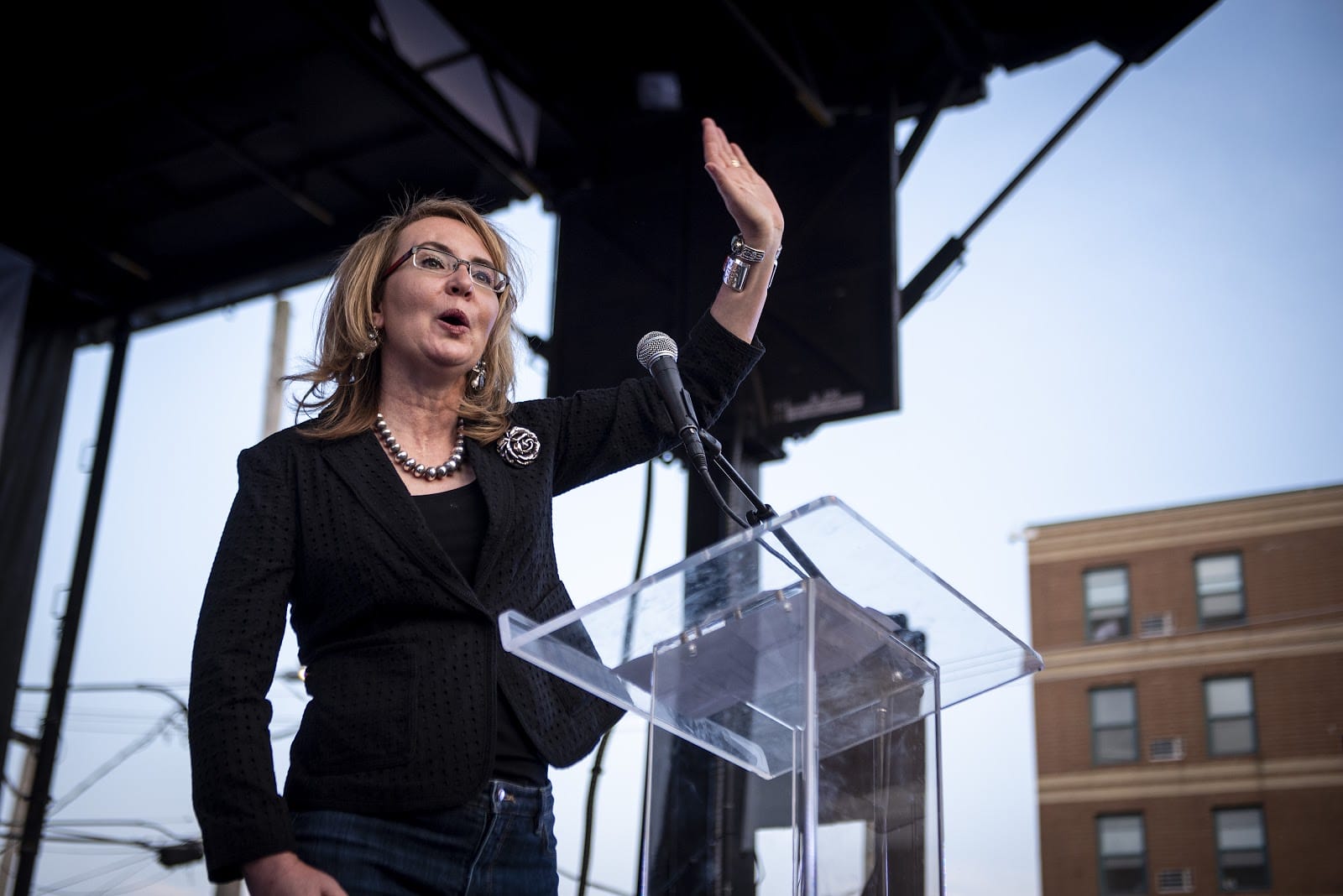
MAKE A GIFT
We’re building a movement of Americans committed to gun safety. Democrats and Republicans, gun owners and non–gun owners alike—we stand united to reject the gun lobby and pass lifesaving gun safety laws.
- Daniel Nass and Champe Barton, “How Many Guns Did Americans Buy Last Month?” The Trace, August 3, 2020, https://www.thetrace.org/2020/08/gun-sales-estimates/.[↩]
- Id, from March 1, 2020, to March 1, 2023.[↩]
- Based on GIFFORDS Law Center’s analysis of gun sale estimates compiled by The Trace. In 2018 and 2019, The Traceestimates that Californians bought 1,624,699 firearms, or 812,350 per year on average. The Traceestimates that Californians bought 2,228,371 guns in the two years from March 1, 2020 to March 1, 2022, and more than 3,065,000 in the three years from March 1, 2020, to March 1, 2023.[↩]
- See California Department of Justice, “Armed and Prohibited Persons System Report 2021,” Figure 5, pp. 17, released March 30, 2022, https://oag.ca.gov/system/files/media/2021-apps-report.pdf.[↩]
- See 2016 CA AB 1673.[↩]
- Office of Gun Violence Prevention, California Department of Justice, “Data Report: The Impact of Gun Violence in California,” August 2023, https://oag.ca.gov/system/files/media/OGVP-Data-Report-2022.pdf.[↩]
- Office of Gun Violence Prevention, California Department of Justice, “Data Report: The Impact of Gun Violence in California,” August 2023, https://oag.ca.gov/system/files/media/OGVP-Data-Report-2022.pdf.[↩]
- Megan Cassidy, “San Francisco supervisors vote to ban untraceable ‘ghost guns’,” San Francisco Chronicle, September 7, 2021, https://www.sfchronicle.com/bayarea/article/San-Francisco-supervisors-vote-to-ban-untraceable-16441684.php.[↩]
- Abené Clayton, “California scrambles to ban ‘ghost guns’ as untraceable weapons’ popularity soars,” The Guardian, September 30, 2021, https://www.theguardian.com/us-news/2021/sep/30/ghost-guns-ban-california-san-francisco-san-diego-los-angeles.[↩]
- “LAPD calls ‘ghost guns’ an ‘epidemic’ as seizures have increased 400% since 2017,” ABC 7, October 18, 2021, https://abc7.com/ghost-guns-los-angeles-lapd-report-gun-epidemic/11141441/.[↩]
- Los Angeles County District Attorney’s Office, “District Attorney George Gascón Asks Credit Card Companies to Halt Online Payments for Ghost Guns,” news release, February 8, 2022, https://da.lacounty.gov/media/news/district-attorney-george-gasc-n-asks-credit-card-companies-halt-online-payments-ghost.[↩]
- Abené Clayton, “Ordered online, assembled at home: the deadly toll of California’s ‘ghost guns’,” The Guardian, May 18, 2021, https://www.theguardian.com/us-news/2021/may/18/california-ghost-guns-deadly-toll.[↩]
- See, e.g., “Man used ‘ghost gun’ to kill 3 daughters in Northern California church,” Mercury News, March 7, 2022, https://www.mercurynews.com/2022/03/07/man-used-ghost-gun-to-kill-3-daughters-in-northern-california-church/; Carter Evans, “Untraceable, but legal, DIY “ghost gun” used in Saugus school shooting, police say,” CBS News, November 23, 2019, https://www.cbsnews.com/news/saugus-high-school-shooter-used-untraceable-diy-ghost-gun/; Grace Toohey, “Suspect used ‘ghost gun’ in killing a Fresno County police officer, officials say,” Los Angeles Times, February 4, 2023, https://www.cbsnews.com/news/saugus-high-school-shooter-used-untraceable-diy-ghost-gun/.[↩]
- Justin Ray, “‘An instrument of death’: The problem of ghost guns in California,” Los Angeles Times, November 15, 2021, https://www.latimes.com/california/newsletter/2021-11-15/ghost-guns-california-essential-california.[↩]
- See Kelly Drane, “Surging Gun Violence: Where We Are, How We Got Here, and Where We Go Next,” GIFFORDS Law Center to Prevent Gun Violence, May 4, 2022, https://GIFFORDS.org/lawcenter/report/surging-gun-violence-where-we-are-how-we-got-here-and-where-we-go/.[↩]
- Devlin Barrett, “2020 saw an unprecedented spike in homicides from big cities to small towns,” Washington Post, December 30, 2020, https://www.washingtonpost.com/national-security/reoord-spike-murders-2020/2020/12/30/1dcb057c-4ae5-11eb-839a-cf4ba7b7c48c_story.html; Kelly Drane, “New 2020 Gun Death Data Underscores the Urgency of This Crisis,” GIFFORDS Law Center to Prevent Gun Violence, December 23, 2021, https://GIFFORDS.org/lawcenter/memo/new-2020-gun-death-data-underscores-the-urgency-of-this-crisis/.[↩]
- The nation’s age-adjusted firearm homicide rate increased from 4.59 per 100,000 residents to 6.19 per 100,000 residents from 2019 to 2020 alone. CDC Underlying Cause of Death 1999-2020 on CDC WONDER Online Database, accessed on March 14, 2023, http://wonder.cdc.gov/ucd-icd10.html.[↩]
- The age-adjusted firearm homicide rate nationally in 2013 was 3.63 per 100,000. In 2022, the age-adjusted firearm homicide rate nationally was 6.16 per 100,000. Centers for Disease Control and Prevention, Wide-ranging Online Data for Epidemiologic Research (WONDER), “Underlying Cause of Death, 2018-2022, Single Race,” last accessed June 17, 2024, https://wonder.cdc.gov/.[↩]
- Id. The nation’s age-adjusted firearm homicide rate increased from 3.64 per 100,000 residents to 6.19 from 2010 to 2020.[↩]
- Calculations include children ages 1–17 and were based on the years 2020, 2021, and 2022. Centers for Disease Control and Prevention, Web-based Injury Statistics Query and Reporting System (WISQARS), “Leading Cause of Death Visualization Tool,” last accessed June 17, 2024, https://www.cdc.gov/injury/wisqars/index.html.[↩]
- From 2013 to 2022, the firearm homicide rate for children 14 years and younger increased by 163% from 0.32 per 100,000 to 0.84 per 100,000. Centers for Disease Control and Prevention, Wide-ranging Online Data for Epidemiologic Research (WONDER), “Underlying Cause of Death, 2018-2022, Single Race,” last accessed June 17, 2024, https://wonder.cdc.gov/.[↩]
- Id. In 2022, among children between the ages of 0 and 17, the cancer death rate was 2.05 per 100,000 compared to the total gun death rate of 3.51 per 100,000.[↩]
- From 2019 to 2020, the age-adjusted firearm homicide rate for California jumped from 3.17 per 100,000 to 4.49. During the same time period, the national age-adjusted firearm homicide rate jumped from 4.59 to 6.19. Centers for Disease Control and Prevention, Wide-ranging Online Data for Epidemiologic Research (WONDER), “Underlying Cause of Death, 2018-2021” last accessed May 4, 2023, https://wonder.cdc.gov/.[↩]
- From 2020 to 2021, the age-adjusted firearm homicide rate in California rose from 4.49 per 100,000 to 4.82 per 100,000. Centers for Disease Control and Prevention, Wide-ranging Online Data for Epidemiologic Research (WONDER), “Underlying Cause of Death, 2018-2021” last accessed May 4, 2023, https://wonder.cdc.gov/.[↩]
- The 2022 age-adjusted firearm homicide rate in California was 4.35 per 100,000 Centers for Disease Control and Prevention, Wide-ranging Online Data for Epidemiologic Research (WONDER), “Underlying Cause of Death, 2018-2022, Single Race,” last accessed June 17, 2024, https://wonder.cdc.gov/.[↩]
- From 2018 to 2022, the Black female age-adjusted firearm homicide rate in California increased from 2.99 per 100,000 to 4.95 per 100,000. From 2018 to 2021, the Black male age-adjusted firearm homicide rate increased from 24.26 per 100,000 to 40.75 per 100,000. Centers for Disease Control and Prevention, Wide-ranging Online Data for Epidemiologic Research (WONDER), “Underlying Cause of Death, 2018-2021” last accessed June 17, 2024, https://wonder.cdc.gov/.[↩]
- See, e.g., California Department of Justice, “Homicide Crime in California 2021,” Table 14, last accessed February 23, 2023, https://data-openjustice.doj.ca.gov/sites/default/files/2022-08/Homicide%20In%20CA%202021.pdf.[↩]
- In 2018, the firearm homicide rate in Alameda County was 3.66 per 100,000 and in 2022 the rate was 7.24 per 100,000 Centers for Disease Control and Prevention, Wide-ranging Online Data for Epidemiologic Research (WONDER), “Underlying Cause of Death, 2018-2022, Single Race,” last accessed June 17, 2024, https://wonder.cdc.gov/.[↩]
- In 2018, the firearm homicide rate was 3.76 per 100,000 in Sacramento County, 4.37 per 100,000 in San Bernardino County, and 4.02 per 100,000 in Fresno County. In 2022, the firearm homicide rate was 5.24 per 100,000 in Sacramento County, 6.61 per 100,000 in San Bernardino County, and 7.58 per 100,000 in Fresno County. Centers for Disease Control and Prevention, Wide-ranging Online Data for Epidemiologic Research (WONDER), “Underlying Cause of Death, 2018-2022, Single Race,” last accessed June 17, 2024, https://wonder.cdc.gov/.[↩]
- In 2018 there were 166,890 total calls for assistance for domestic violence and 162,422 such calls in 2022. In 2018 there were 1,383 calls for assistance for domestic violence involving a firearm and 2,132 such calls in 2022. California Department of Justice, “Domestic Violence-Related Calls for Assistance,” last accessed June 15, 2024, https://openjustice.doj.ca.gov/exploration/crime-statistics/domestic-violence-related-calls-assistance.[↩]
- In 2018, the female gun homicide rate statewide in California was 0.9 per 100,000 and in 2022 the rate was 1.07 per 100,000. From 2018 to 2022, the non-Hispanic Black female gun homicide rate in California rose 66% from 2.99 per 100,000 to 4.95 per 100,000. From 2018 to 2022, the Hispanic female gun homicide rate in California rose 14% from 0.95 per 100,000 to 1.08 per 100,000. Centers for Disease Control and Prevention, Wide-ranging Online Data for Epidemiologic Research (WONDER), “Underlying Cause of Death, 2018-2022, Single Race,” last accessed June 17, 2024, https://wonder.cdc.gov/.[↩]
- In 2018, there were 11,148 total assaults on law enforcement officers in California, 282 of which involved a firearm. In 2022, there were 12,304 total assaults on law enforcement officers in California, 362 of which involved a firearm. “Law Enforcement Officers Killed or Assaulted,” last accessed June 17, 2024, https://openjustice.doj.ca.gov/data.[↩]
- Based on calculations made by GIFFORDS Law Center. California Department of Justice, “Law Enforcement Officers Killed or Assaulted,” last accessed June 17, 2024, https://openjustice.doj.ca.gov/data.[↩]
- In 2022, there were 836 Latino gun homicide victims and 522 non-Hispanic Black gun homicide victims. In 2022, 1,358 people died from gun homicides in California. Centers for Disease Control and Prevention, Wide-ranging Online Data for Epidemiologic Research (WONDER), “Underlying Cause of Death, 2018-2022, Single Race,” last accessed June 17, 2024, https://wonder.cdc.gov/.[↩]
- From 2018 to 2022 in California among non-Hispanic white males ages 15–24, there were 125 gun homicides and 3,042 total deaths. Centers for Disease Control and Prevention, Wide-ranging Online Data for Epidemiologic Research (WONDER), “Underlying Cause of Death, 2018-2022, Single Race,” last accessed June 18, 2024, https://wonder.cdc.gov/.[↩]
- From 2018 to 2022 in California among non-Hispanic Asian Native Hawaiian and Pacific Islander males ages 15–24, there were 47 gun homicides and 775 total deaths. Centers for Disease Control and Prevention, Wide-ranging Online Data for Epidemiologic Research (WONDER), “Underlying Cause of Death, 2018-2022, Single Race,” last accessed June 18, 2024, https://wonder.cdc.gov/.[↩]
- From 2018 to 2022 in California among Hispanic males ages 15–24, there were 1,111 gun homicides and 6,627 total deaths. Centers for Disease Control and Prevention, Wide-ranging Online Data for Epidemiologic Research (WONDER), “Underlying Cause of Death, 2018-2022, Single Race,” last accessed June 18, 2024, https://wonder.cdc.gov/.[↩]
- From 2018 to 2022 in California among non-Hispanic Black males ages 15–24, there were 537 gun homicides and 1,493 total deaths. Centers for Disease Control and Prevention, Wide-ranging Online Data for Epidemiologic Research (WONDER), “Underlying Cause of Death, 2018-2022, Single Race,” last accessed June 18, 2024, https://wonder.cdc.gov/.[↩]
- From 2018 to 2022, among Black males ages 15 to 24 in California there were 537 gun homicides and 574 total homicides. Centers for Disease Control and Prevention, Wide-ranging Online Data for Epidemiologic Research (WONDER), “Underlying Cause of Death, 2018-2022, Single Race,” last accessed June 18, 2024, https://wonder.cdc.gov/.[↩]
- From 2018 to 2022, the firearm homicide rate in Kern County was 9.71 per 100,000. During the same time period the statewide rate was 3.96 per 100,000. = Centers for Disease Control and Prevention, Wide-ranging Online Data for Epidemiologic Research (WONDER), “Underlying Cause of Death, 2018-2022, Single Race,” last accessed June 18, 2024, https://wonder.cdc.gov/.[↩]
- From 2018 to 2022, the crude firearm homicide rate in San Joaquin County was 7.50 per 100,000 and in Fresno County the rate was 7.31 per 100,000. Statewide from 2018 to 2022, the crude firearm homicide rate was 3.96 per 100,000. Centers for Disease Control and Prevention, Wide-ranging Online Data for Epidemiologic Research (WONDER), “Underlying Cause of Death, 2018-2022, Single Race,” last accessed June 18, 2024, https://wonder.cdc.gov/.[↩]
- From 2018 to 2022 the crude firearm homicide rates in these counties were as follows: Merced County (6.32 per 100,000), Solano County (6.02 per 100,000), San Bernardino County (5.88 per 100,000), and Alameda County (5.43 per 100,000). Centers for Disease Control and Prevention, Wide-ranging Online Data for Epidemiologic Research (WONDER), “Underlying Cause of Death, 2018-2022, Single Race,” last accessed June 18, 2024, https://wonder.cdc.gov/.[↩]
- The statewide female crude gun homicide rate from 2018 to 2022 was 0.99 per 100,000. In these three counties the crude gun homicide rates during the same period were 2.35 per 100,000 in Kern County and 2.35 per 100,000 in Fresno County. Centers for Disease Control and Prevention, Wide-ranging Online Data for Epidemiologic Research (WONDER), “Underlying Cause of Death, 2018-2022, Single Race,” last accessed June 18, 2024, https://wonder.cdc.gov/.[↩]
- From 2018 to 2022 there were 111 female gun homicides in Kern and Fresno Counties. Statewide during the same period there were 974. Centers for Disease Control and Prevention, Wide-ranging Online Data for Epidemiologic Research (WONDER), “Underlying Cause of Death, 2018-2022, Single Race,” last accessed June 18, 2024, https://wonder.cdc.gov/.[↩]
- From 2018 to 2022, there were 2,491 gun homicides in Los Angeles County and 7,790 statewide. Centers for Disease Control and Prevention, Wide-ranging Online Data for Epidemiologic Research (WONDER), “Underlying Cause of Death, 2018-2022, Single Race,” last accessed June 18, 2024, https://wonder.cdc.gov/.[↩]
- Based on calculations made by GIFFORDS Law Center. Gun Violence Archive, last accessed August 29, 2024, https://www.gunviolencearchive.org/.[↩]
